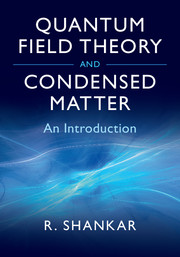Book contents
- Frontmatter
- Dedication
- Contents
- Preface
- 1 Thermodynamics and Statistical Mechanics Review
- 2 The Ising Model in d = 0 and d = 1
- 3 Statistical to Quantum Mechanics
- 4 Quantum to Statistical Mechanics
- 5 The Feynman Path Integral
- 6 Coherent State Path Integrals for Spins, Bosons, and Fermions
- 7 The Two-Dimensional Ising Model
- 8 Exact Solution of the Two–Dimensional Ising Model
- 9 Majorana Fermions
- 10 Gauge Theories
- 11 The Renormalization Group
- 12 Critical Phenomena: The Puzzle and Resolution
- 13 Renormalization Group for the ϕ4 Model
- 14 Two Views of Renormalization
- 15 Renormalization Group for Non-Relativistic Fermions: I
- 16 Renormalization Group for Non-Relativistic Fermions: II
- 17 Bosonization I: The Fermion–Boson Dictionary
- 18 Bosonization II: Selected Applications
- 19 Duality and Triality
- 20 Techniques for the Quantum Hall Effect
- Index
- References
20 - Techniques for the Quantum Hall Effect
Published online by Cambridge University Press: 24 October 2017
- Frontmatter
- Dedication
- Contents
- Preface
- 1 Thermodynamics and Statistical Mechanics Review
- 2 The Ising Model in d = 0 and d = 1
- 3 Statistical to Quantum Mechanics
- 4 Quantum to Statistical Mechanics
- 5 The Feynman Path Integral
- 6 Coherent State Path Integrals for Spins, Bosons, and Fermions
- 7 The Two-Dimensional Ising Model
- 8 Exact Solution of the Two–Dimensional Ising Model
- 9 Majorana Fermions
- 10 Gauge Theories
- 11 The Renormalization Group
- 12 Critical Phenomena: The Puzzle and Resolution
- 13 Renormalization Group for the ϕ4 Model
- 14 Two Views of Renormalization
- 15 Renormalization Group for Non-Relativistic Fermions: I
- 16 Renormalization Group for Non-Relativistic Fermions: II
- 17 Bosonization I: The Fermion–Boson Dictionary
- 18 Bosonization II: Selected Applications
- 19 Duality and Triality
- 20 Techniques for the Quantum Hall Effect
- Index
- References
Summary
The quantum Hall effect (QHE) has captivated the attention of theorists and experimentalists following its discovery. First came the astounding integer quantum Hall effect (IQHE) discovered by von Klitzing, Dorda, and Pepper in 1980 [1]. Then came the even more mysterious discovery of the fractional quantum Hall effect (FQHE) by Tsui, Störmer, and Gossard in 1982 [2]. Obviously I cannot provide even an overview of this vast subject. Instead, I will select two techniques that come into play in the theoretical description of the FQHE. Along the way I will cover some aspects of IQHE. However, of necessity, I will be forced to leave out many related developments, too numerous to mention. The books in [3–7] and online notes in [8] may help you with further reading.
The first technique is due to Bohm and Pines (BP) [9], and was used to describe an excitation of the electron gas called the plasmon. Since the introduction by BP of this technique in first quantization, it has been refined and reformulated in the diagrammatic framework. I will stick to the wavefunction-based approach because it is very beautiful, and because two of the great problems in recent times – the theory of superconductivity and the theory of the FQHE – were first cracked open by ingenious trial wavefunctions that captured all the essentials. I will introduce the BP approach in terms of the electron gas.
The second technique is Chern–Simons field theory. Originally a product of the imaginations of the mathematicians S. S. Chern and J. Simons, it first entered particle physics in the work of Deser, Jackiw, and Templeton [10], and then condensed matter [11–14]. I will describe its role in the FQHE after introducing the problem to you.
The Bohm–Pines Theory of Plasmons: The Goal
Consider a system of N spinless fermions experiencing the Coulomb interaction
Invoking the Fourier transformation (in unit spatial volume)
we find that
is the density operator (in first quantization), and the q=0 component is presumed to have been neutralized by some background charge.
- Type
- Chapter
- Information
- Quantum Field Theory and Condensed MatterAn Introduction, pp. 384 - 434Publisher: Cambridge University PressPrint publication year: 2017



